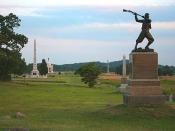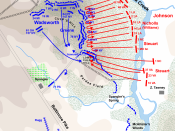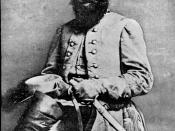The most important battle of the Civil War After much fierce fighting and heavy casualties on both sides, the Federals were pushed back through the town of Gettysburg and regrouped south of the town along the high ground near the cemetery (which is here on my map).
Lee ordered Confederate General R.S. Ewell to seize the high ground from the battle tired Federals . Gen. Ewell hesitated to attack thereby giving the Union troops a chance to dig in along Cemetery Ridge and bring in reinforcements with artillery. By the time Lee realized Ewell had not attacked, it was too late to attempt the attack.
Meade arrived at the area and thought it was an ideal place to do battle with the Rebel army. He expected a massive number of Union soldiers totaling up to 100,000to arrive and strengthen his defensive position.
Confederate General James Lonstreet saw the Union position as nearly impenetrable and told Lee it should be left alone.
He argued that the Confederate Army should instead move east between the Union Army and Washington and build a defensive position thus forcing the Federals to attack them instead. But Lee believed his army was invincible and he also didn't have his cavalry which served as his eyes and ears. With his cavalry he could track the Unions troop movements. Cavalry leader Jev Stuart had gone off with his troops to harass the Federals leaving Lee with a disadvantage.
Lee decided to attack the Union Army's defensive position at the southern end of Cemetery Ridge which he thought was less defended.
Around 10 a.m. the next morning, Thursday, July 2, Gen. Lonstreet was ordered by Lee to attack. but Lonstreet was quite slow in getting his troops into position and didn't even attack them until 4 p.m. that afternoon. This gave the Union Army more time to strengthen their position.
When Longstreet attacked, some of the most bitter fighting of the Civil War erupted at places now part of American military folklore such as Little Round Top, Devil's Den, the Wheat Field and the Peach Orchard (which can all be seen on my model). Longstreet took the Peach Orchard but was driven back at Little Round Top.
About 6:30 p.m. Gen. Ewell attacked the Union Line from the north and east at Cemetery Hill and Culp's Hill (which can be seen on my model also). The attack lasted into darkness but was finally decided unsuccessful at Cemetery Hill, although Rebels seized some trenches on Culp's Hill.
By about 10:30 p.m., the day's fighting came to and end. The Federals had lost some ground during the Rebel onslaught but still held the strong defensive position along Cemetery Ridge. Both sides regrouped and counted their causalities.
Generals from each side gathered in war councils to plan for the coming day. Union commander Meade decided his army would remain in place and wait for Lee to attack. On the Confederate side, Longstreet once again tried to talk Lee out of attacking such a strong position. But lee thought the beaten up Union soldiers were nearly done and fall under one last push.
As dawn broke on Friday, July 3, about 4:30 a.m., Lee's timetable was undermined as Union cannons pounded the Rebels on Culp's Hill to drive them from the trenches. The Rebels did not withdraw, but instead attacked the Federals around 8 a.m. Thus began a vicious three hour struggle with the Rebels constantly charging up the hill only to be repelled back. The Federals finally counter attacked and drove the Rebels off the hill and east across the Rock Creek. Around 11 a.m. the fighting on Culp's Hill stopped. Then an eerie quiet settled over the battlefield.
And again, Lee encountered arguments about his battle plan from Longstreet. Lee estimated about 15,000 men would participate in the Rebel charge on Cemetery Ridge. Longstreet responded, "It is my opinion that no 15,000 men ever arrayed for battle can take that position.". But of course Lee did it his way.
Throughout the morning and into the afternoon there was a 90 degree temperature and high humidity. Through this the Rebels moved into position in the woods opposite Cemetery Ridge for the coming charge. Interestingly, some Union troops were moved away from Cemetery Ridge on Mead's orders because he thought Lee would attack again in the south. Several hours before, Mead had correctly predicted Lee would attack the center, but now thought otherwise. He left only 5,750 infantry men stretched out along the half-mile front to initially face a 13,000 man Rebel charge.
Lee sent Jeb Stuart's recently returned cavalry to go behind the Union position in order to divert Federal forces from the main battle area. Around noon, Union and Confederate cavalry troops battled three miles east of Gettysburg but Stuart was eventually repulsed by cannon fire led in part by Gen. George Custer and the Union Cavalry. The diversion attempt failed.
Back at the main battle site, just after 1 p.m. about 170 Confederate cannons opened fire on the Union position on Cemetery Ridge to pave the way for the Rebel Charge. This was the heaviest artillery barrage of the war. The Federals returned heavy cannon fire and soon the battlefield was covered in smoke and dust. Around 2:30 p.m. the Federals slowed their rate of fire, then stopped firing, to conserve ammunition and to fool he Rebels into thinking the cannons were knocked out-and thats exactly what the Rebels thought too.
But as the Rebels got within range, Federal cannons opened fire using grapeshot which is a shell containing iron balls that flew apart when fired, and they also used deadly waves of rifle fire. Soon the Rebel army was torn apart but they still moved forward.
Pickett's charge was almost more after the once majestic army of 13,000 had its numbers of troops dwindle.. The Rebels still move forward, shooting then charging with bayonets. The battle lasted for about and hour mostly of hand-to-hand combat. Finally what was left of Pickett's charge (5,500) retreated .
Lee admitted this was his mistake and the tide of war now turned in the North's favor. The Union lost (either dead, wounded, or missing) about 23,000, and the Confederates lost about 28,000.
That night and into the next day, Saturday, July4, Confederate wounded were loaded on wagons that began the trop back toward the South. Lee was forced to take his army and retreat back to Virginia. Union commander Meade, out of fatigue and caution , did not immediately pursue Lee, infuriating President Lincoln who wrote a bitter letter to Meade (pass out). Lincoln said he missed a "golden opportunity" to end the war right there.
![Socialists in Union Square, N.Y.C. [large crowd] Photo, 1 May 1912 - Bain Coll. (LOC)](https://s.writework.com/uploads/5/54413/socialists-union-square-n-y-c-large-crowd-photo-1-may-1912-b-thumb.jpg)
![[Unidentified young soldier in Union uniform and forage cap] (LOC)](https://s.writework.com/uploads/9/99956/unidentified-young-soldier-union-uniform-and-forage-cap-loc-thumb.jpg)



